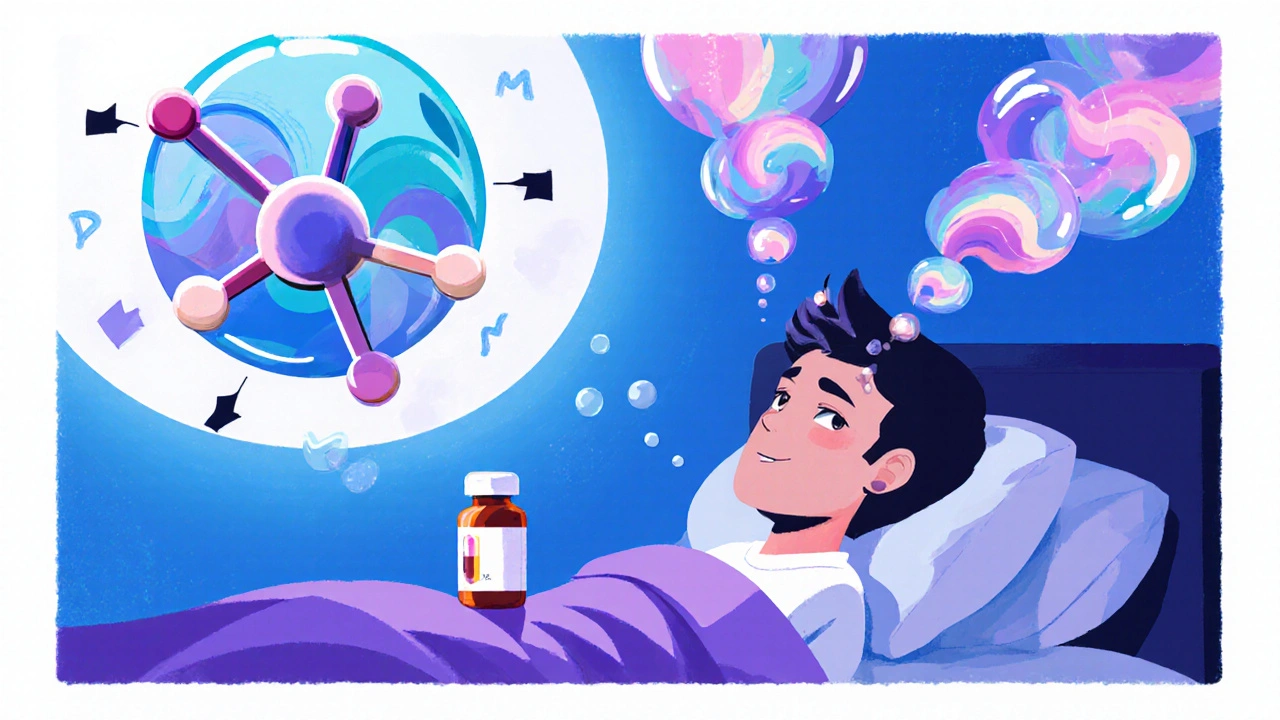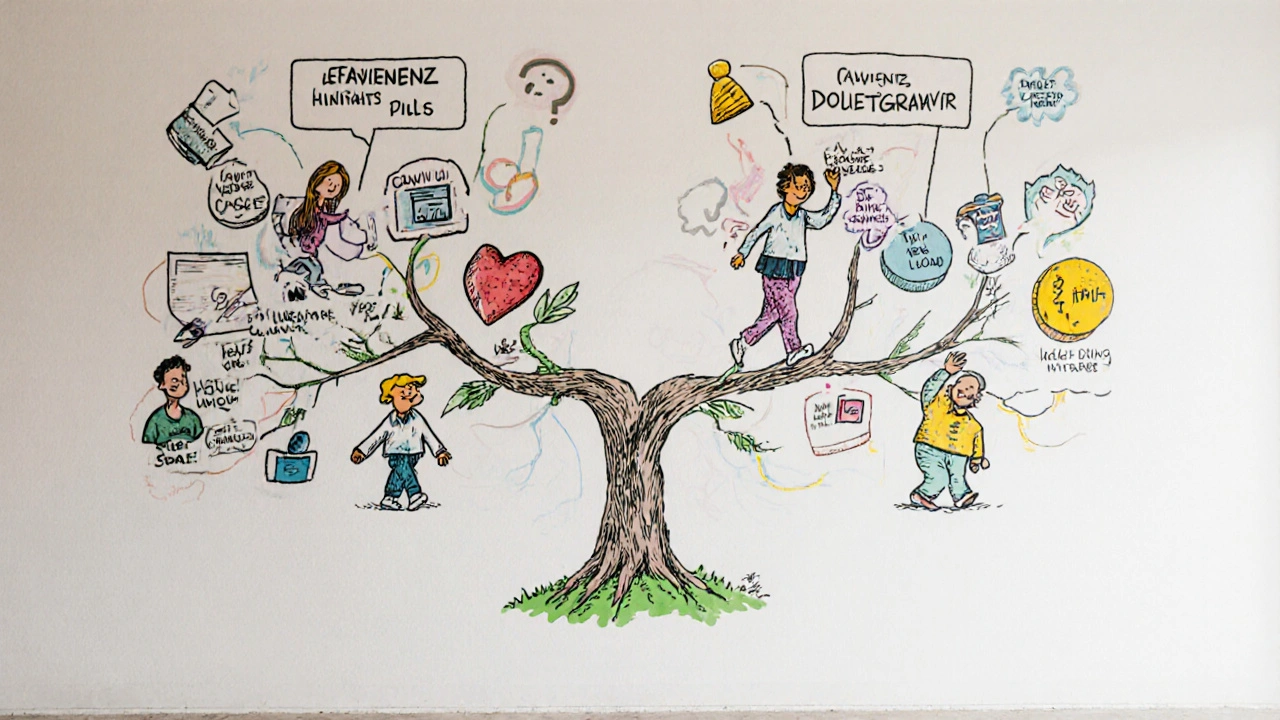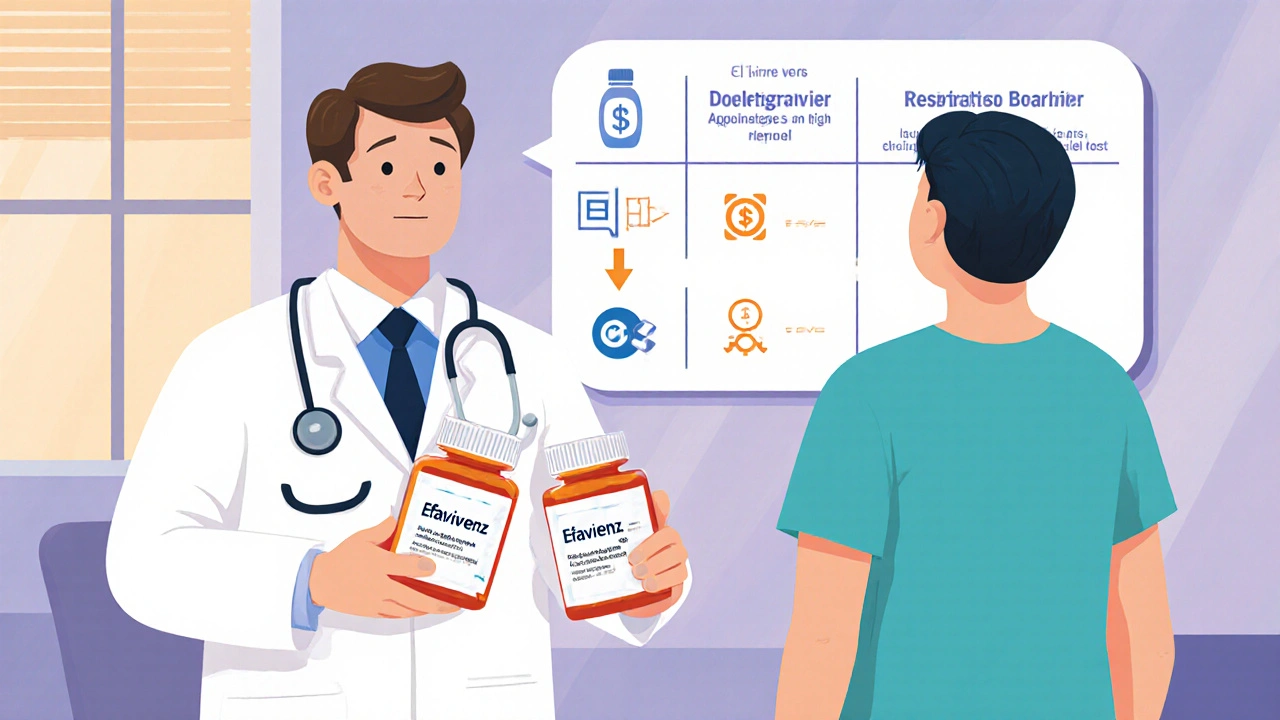HIV Treatment Decision Tool
Patient Assessment
Recommendation Summary
Quick Summary
- Sustiva (Efavirenz) is a non‑nucleoside reverse transcriptase inhibitor (NNRTI) widely used in first‑line HIV regimens.
- Newer options like dolutegravir and bictegravir offer higher genetic barriers to resistance.
- Side‑effect profiles differ: Efavirenz can cause vivid dreams, while integrase inhibitors usually have milder neuro‑psychiatric reactions.
- Cost varies by country; generic efavirenz is cheap, but some newer drugs are subsidised in high‑income settings.
- Choosing the right alternative depends on resistance history, comorbidities, and patient preference.
When you search for "Sustiva alternatives," you probably want to know whether to stay with efavirenz or switch to a newer compound. The following guide breaks down the science, the side‑effects, the price, and the real‑world data that help you decide.
Sustiva is the brand name for efavirenz, a non‑nucleoside reverse transcriptase inhibitor (NNRTI) used in combination antiretroviral therapy (cART) for HIV‑1 infection. It was approved by the FDA in 1998 and quickly became a cornerstone of World Health Organization (WHO) first‑line regimens.
How Efavirenz Works and Where It Fits in Modern Therapy
Efavirenz binds directly to the HIV‑1 reverse transcriptase enzyme, causing a conformational change that blocks the enzyme’s ability to copy viral RNA into DNA. This stops the virus from integrating into host cells. Because it targets a different site than nucleoside reverse transcriptase inhibitors (NRTIs), efavirenz pairs well with drugs like tenofovir and emtricitabine.
However, efavirenz has a low genetic barrier to resistance. A single mutation at position K103N can reduce its potency dramatically. That’s why treatment‑experienced patients often need a drug with a higher barrier, such as an integrase strand transfer inhibitor (INSTI).
Key Criteria for Comparing Efavirenz with Alternatives
When you stack up efavirenz against other options, focus on these six dimensions:
- Efficacy - viral suppression rates at 48weeks.
- Resistance profile - how many mutations are needed to break the drug.
- Side‑effect burden - neuro‑psychiatric, metabolic, and hepatic issues.
- Drug‑drug interactions - especially with CYP450‑metabolised medicines.
- Cost & accessibility - generic availability versus patented pricing.
- Convenience - pill count, dosing frequency, and food requirements.
Below is a side‑by‑side look at the most common alternatives.
| Drug | Class | Typical Dose | 48‑week Suppression % | Key Side‑effects | Resistance Barrier | Average Monthly Cost (US$) |
|---|---|---|---|---|---|---|
| Sustiva (Efavirenz) | NNRTI | 600mgoncedaily | 84‑88 | Vivid dreams, dizziness, rash | Low - single‑mutant resistance | 5‑15 (generic) |
| Nevirapine | NNRTI | 200mgtwicedaily | 80‑84 | Hepatotoxicity, rash | Low‑moderate | 3‑10 |
| Dolutegravir | INSTI | 50mgoncedaily | 92‑95 | Insomnia, headache | High - requires multiple mutations | 25‑35 (generic 2025) |
| Raltegravir | INSTI | 400mgtwicedaily | 88‑90 | Elevated CK, nausea | Moderate | 30‑40 |
| Maraviroc | CCR5 antagonist | 300mgtwicedaily | 79‑82 | Diarrhea, cough | High (requires CCR5‑tropic virus) | 45‑55 |

Side‑Effect Spotlight: Why Efavirenz Still Gets Mentioned
Efavirenz earned a reputation for causing vivid, sometimes scary dreams. A 2023 meta‑analysis of 12RCTs reported that 15‑20% of patients on efavirenz experienced sleep disturbances, versus <5% on dolutegravir. The mechanism ties to efavirenz’s ability to cross the blood‑brain barrier and modulate central nervous system (CNS) receptors.
On the plus side, efavirenz rarely raises triglycerides, a common issue with some protease inhibitors. If a patient has a history of depression, many clinicians now prefer an INSTI to avoid exacerbating mood symptoms.
Drug‑Drug Interactions: The CYP450 Factor
Efavirenz is a strong inducer of CYP3A4 and CYP2B6. That means it can lower the plasma levels of many co‑administered drugs, including certain antiepileptics, hormonal contraceptives, and some anti‑TB medications (rifampicin). Conversely, protease inhibitors like ritonavir boost efavirenz levels, raising the risk of CNS toxicity.
Integrase inhibitors such as dolutegravir are less prone to CYP‑mediated interactions. Dolutegravir does require a cation‑rich meal to improve absorption, but it plays nicely with most chronic meds, making it a safer pick for poly‑pharmacy patients.
Cost, Availability, and Global Guidelines
The World Health Organization’s 2023 HIV treatment guidelines still list efavirenz‑based regimens as a viable first‑line option for low‑resource settings, mainly because the drug is off‑patent and available for under US$10 per month in many generic markets.
In high‑income countries, dolutegravir and bictegravir have become the preferred first‑line agents thanks to their superior barrier to resistance and milder side‑effect profile, even though their price tags can be three‑to‑five times higher. Some insurers, however, negotiate rebates that bring the net cost down to around US$30‑40 per month.

Best‑Fit Scenarios: When to Stick with Efavirenz and When to Switch
Stay with Efavirenz if:
- You’re initiating therapy in a resource‑limited clinic with reliable access to generic efavirenz.
- The patient has no history of psychiatric illness and is comfortable with once‑daily dosing.
- There are no major CYP450‑interacting drugs in the regimen.
Consider an Alternative if:
- Baseline viral load is >100,000copies/mL - integrase inhibitors achieve faster suppression.
- Patient reports or has a diagnosis of depression, anxiety, or sleep disorders.
- There’s documented NNRTI resistance (e.g., K103N mutation).
- They are on hormonal contraception that could be less effective with efavirenz.
Putting It All Together: A Decision Tree
- Is the patient treatment‑naïve?
Yes → Go to step2. No → Check resistance profile first. - Do they have any psychiatric or sleep issues?
Yes → Prefer dolutegravir or bictegravir. - Are they on medications that are strong CYP3A4 substrates?
Yes → Avoid efavirenz; choose an INSTI. - Is cost a limiting factor?
Yes → Generic efavirenz or nevirapine may be the only affordable option. - Confirm viral load < 100k copies/mL and no resistance → Efavirenz is acceptable.
Frequently Asked Questions
Can I take efavirenz with my birth control pill?
Efavirenz induces CYP3A4, which can lower hormone levels and make oral contraceptives less effective. If you rely on the pill, discuss a backup method or switch to a non‑hormonal option.
Why does efavirenz cause vivid dreams?
Efavirenz crosses the blood‑brain barrier and binds to central nervous system receptors, altering neurotransmitter activity. The effect peaks 4‑6hours after dosing, which is why taking it at night can intensify dream vividness.
Is dolutegravir safe during pregnancy?
Yes, the WHO and CDC consider dolutegravir safe in pregnancy. Recent data (2024) show lower rates of neural‑tube defects compared with older integrase inhibitors, making it a preferred option for pregnant women.
How quickly does efavirenz lower viral load?
In most RCTs, efavirenz‑based regimens achieve a <150copies/mL viral load by week24 in about 80% of patients, reaching the <50copies/mL threshold for 84‑88% at week48.
What should I do if I miss a dose of efavirenz?
Take the missed dose as soon as you remember, unless it’s less than 12hours later. In that case, skip it and resume the regular schedule to avoid double‑dosing, which can increase CNS side‑effects.


All Comments
Fabian Märkl October 17, 2025
Hey everyone, just throwing out a quick reminder that efavirenz still has a solid place in many first‑line combos if cost is a major factor 😄. It’s cheap, well‑studied, and for patients without psychiatric history it can work just fine. Remember to check for that K103N mutation before you lock someone in, though. Also, taking it with food can help reduce the dizziness for some folks.
Avril Harrison October 29, 2025
Totally get that – the price tag can be a real deal‑breaker, especially in resource‑limited settings.
Natala Storczyk November 9, 2025
BUT DO NOT BE FOOLISH ENOUGH TO IGNORE THE RESISTANCE WARNINGS!!! ONE MUTATION AND EFAVIRENZ CAN TURN INTO A COMPLETE FAILURE!!! THE VIVID DREAMS ARE JUST THE TIP OF THE ICEBERG!!! IF YOU’RE NOT WILLING TO MONITOR VIRAL LOAD EVERY FOUR WEEKS, YOU’RE PLAYING WITH FIRE!!!
nitish sharma November 21, 2025
In the context of contemporary antiretroviral therapy, it is imperative to assess efavirenz not merely on the basis of cost but also on pharmacokinetic interactions, resistance profiles, and patient‑centred outcomes. The drug’s induction of cytochrome‑P450 enzymes, particularly CYP3A4, can diminish the efficacy of concomitant medications such as hormonal contraceptives, certain antiepileptics, and antiretrovirals that rely on the same metabolic pathway. Accordingly, clinicians must perform a thorough medication reconciliation prior to initiating therapy. Moreover, the low genetic barrier associated with efavirenz necessitates vigilance for the K103N mutation, which can emerge after limited exposure and compromise viral suppression. Data from the 2023 meta‑analysis indicate that patients harbouring this mutation exhibit a median decline in suppression rates from 88 % to approximately 60 % at 48 weeks. While the drug’s side‑effect profile, including vivid dreams and central nervous system disturbances, may be tolerable for some, it can be intolerable for others, leading to poor adherence. The impact of neuropsychiatric adverse events on quality of life has been documented in several longitudinal cohorts, underscoring the need for individualized risk‑benefit discussions. In contrast, the newer integrase strand transfer inhibitors, such as dolutegravir and bictegravir, demonstrate higher barriers to resistance and a more favourable neuro‑cognitive tolerance. Nevertheless, the financial implications of these agents remain prohibitive in many low‑income regions, where generic efavirenz is available for as little as five dollars per month. From a public health perspective, the balance between accessibility and optimal therapeutic efficacy continues to evolve as patent expirations broaden generic availability of newer agents. It is also noteworthy that efavirenz’s once‑daily dosing regimen aligns with adherence‑enhancing strategies, whereas some integrase inhibitors require twice‑daily administration in their older formulations. Clinicians must also consider the potential for drug‑drug interactions with antiretroviral regimens that include protease inhibitors, as efavirenz may either potentiate or attenuate plasma concentrations depending on the co‑administered compound. Furthermore, the pharmacodynamic effect of efavirenz on lipid metabolism, though modest, may influence cardiovascular risk profiles in long‑term users. Ultimately, the decision matrix should incorporate viral load benchmarks, resistance testing, comorbid conditions, and patient preferences, while remaining cognizant of the evolving evidence base. Regular monitoring, patient education, and prompt management of adverse events are essential components of any efavirenz‑based regimen.
Rohit Sridhar December 3, 2025
Great points, nitish! Balancing cost and efficacy can feel like walking a tightrope, but there’s always a path forward. If a patient is worried about the dreams, trying a bedtime dose or switching to an integrase inhibitor could be a game‑changer. Keep the dialogue open, and remember that many clinics now have access to discounted dolutegravir through global health programs. Together we can find the sweet spot that keeps viral loads down and spirits up.